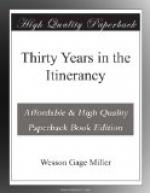The name of Milwaukee has, doubtless, come down to us from some extinct tribe of the aboriginal inhabitants of the country, as there seems to be nothing that will fully answer to it in any of the tongues now in use. In 1680 Zenobius Membre mentions the river of Melleoke, flowing into Lake Dauphan, in latitude forty, with an Indian village at its mouth. Three generations later Lieut. Gorrell visited Milwacky River, and found a village on its bank, with an Indian trader.
Another interval of a generation occurred, and Solomon Juneau appeared and took up his residence in Milwaukee in 1818. Other fur traders came soon after, but the real settlement of the country did not begin until 1835, when nine families came, forming the nucleus of the future city.
The first Protestant sermon preached in Milwaukee was delivered by a Methodist clergyman in June, 1835. The meeting was held in a log house, erected by Dr. Enoch Chase for a residence, near the mouth of the river.
Milwaukee Mission was organized by the Illinois Conference in the summer of 1835, and Rev. Mark Robinson, who had been admitted that year, was appointed to the charge. The Presiding Elder of the District, which extended from Chicago to Green Bay, was the veteran pioneer, Rev. John Clark. The Presiding Elder visited Milwaukee during this year and preached a sermon in the residence of Dr. Chase, this being at that time the principal place in which meetings were held. Both the Pastor and Presiding Elder were entertained by the Doctor.
The population of the village was very small, but before the expiration of the Conference year Brother Robinson was able to form a class of four members. These first members were David Worthington, Mrs. Samuel Brown, Mrs. J.K. Lowry, and Mrs. Farmin.
In the autumn of 1836 Rev. William S. Crissey was sent to Milwaukee. The congregations were now growing, and it was found expedient to provide some place, other than a private residence, for the meetings. The Society was not able to build, and to rent a suitable place seemed impossible. In this embarrassment a carpenter’s shop belonging to two members of the church, W.A. and L.S. Kellogg, was deemed the most feasible arrangement. This building, located on the corner of East Water and Huron Streets, was a frame structure, and stood on posts. Beneath and all around it was a pond of water, and to gain an entrance a narrow bridge was constructed from the street to the door. The first Quarterly Meeting was held in this place by Rev. John Clark, on the 8th and 9th of January, 1837. At this meeting the Pastor reported the conversion of Mr. J.K. Lowry, doubtless the first in the village.
The legal organization of the Church, according to
the laws of the
Territory, was effected July 22d, 1837, with Elah
Dibble as Chairman and
W.A. Kellogg as Secretary. The first Trustees
were Elah Dibble, David
Worthington, W.A. Kellogg, L.S. Kellogg,
J.K. Lowry, Jared Thompson and
Joseph E. Howe. The fourth Quarterly Meeting
was held July 29th, and the
Pastor reported a membership of forty-five.




